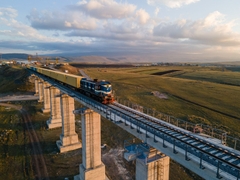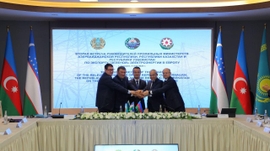Aiming to diversify its economy, Kazakhstan’s government has been launching programs to encourage entrepreneurs and provide assistance to small- and medium-sized business owners.
Prime Minister Bakytzhan Sagintayev led a meeting on Saturday that focused on possibly launching a new International Science Park in Astana that would lend a helping hand to IT startups in particular, and operate within the Astana International Financial Center. The financial center is set to open its doors after EXPO 2017, the world’s fair currently underway in Astana, wraps up on September 10.
Looking to woo foreign investors and domestic technology entrepreneurs, working and living spaces would be provided and visa restrictions for foreigners are to be eased. Investment would come from the country’s large quasi-public and private companies.
The interest in building up Kazakhstan’s entrepreneurial activity and diversifying its largely hydrocarbon-reliant economy is coming from the very top. In January, President Nursultan Nazarbayev gave a major speech in which he outlined his vision for the country’s future, saying a new model of economic growth is needed that will allow Kazakhstan to compete globally. Nazarbayev pegged changes in the economy to technological modernization.
“We should cultivate new industries, which are created involving the use of digital technologies,” the 77 year-old president said. “It’s critical to cultivate such sunrise industries as 3D printing, online commerce, mobile banking, digital services, including health and education sectors, and others. These sectors have changed the economic structure of the developed countries,” Nazarbayev emphasized, laying out five key priorities for Kazakhstan’s growth, with the intention that the country will become one of the world’s leading 30 economies by 2050.
With a GDP of over $128 billion, Kazakhstan is Central Asia’s leading economy and the third largest in the Caspian region, after Russia and Iran. Any success in the private sector is largely attributed to government-led efforts to deregulate what were once Soviet state-run industries, and provide the necessary support to Kazakhstani businesses looking to flourish in what is an increasingly decentralized economy.
As one of five Central Asian Republics born out of the dissolution of the Soviet Union in 1991, Kazakhstan has undergone multiple stages of privatization over the past quarter century. In the first year of independence, more than 4,770 organizations were privatized, including 472 state farms that had been run by the Soviet Union.
From 1993-95, more than 6,000 state-owned assets were sold off, netting roughly $30 million for the national exchequer. Within another three years, 615 joint-stock companies and 2,905 social facilities were sold off, and foreigners were first let in to invest. The longest period of reform ran from 1998 until 2013, during which time communal properties were dissolved and in turn led to a sharp increase in local revenues.
In 2015, leaders in Astana approved a new five-year privatization plan that aimed to reduce state participation in the economy to 15 percent, which is the level set by the Organization for Economic Cooperation and Development. The plan will see 60 major state-owned companies become privatized before January 1, 2018, including energy distribution companies, banks, airlines, and companies involved in infrastructure development.
Last year the Ministry of National Economy presented a list of about 260 state companies and subsidiaries of national holdings that should be privatized by 2020, including giants like Kazakstan Temir Zholy, the country’s national railway company; Kazatomprom, the state-owned company responsible for importing and exporting uranium, rare- and rare-earth metals; Kazpost, the national postal service; Air Astana, Kazakhstan’s principle airline and flag carrier; KazMunaiGas, Kazkahstan’s oil and gas company; and Samruk-Energy, a joint stock company that forms part of the giant sovereign wealth fund Samruk-Kazyna.
But privatizing big industry is not the government’s endpoint, and igniting the potential of entrepreneurs is considered a top priority.
Government schemes to do just that include the Program for the Development of Productive Employment and Mass Entrepreneurship, which runs through 2021 and allows the government to provide microloans of up to 16 million tenge, or about $50,000, to qualified applicants.
Joint ventures with foreign countries are also being established. South Korea has partnered to create the Damu Entrepreneurship Development Fund Joint Stock Company. Operating alongside the SBC Korea Small & Medium Business Corporation, Damu, meaning “development” in the Kazakh language, provides free access to multi-space zones in Astana, where Kazakhstani entrepreneurs will receive mentorship and consulting services free of charge for up to two months, as well as help with finding private investors for funding.
Already operating in four universities throughout the country – Eurasian Technological University in Almaty, Eurasian National University in Astana, Pavlodar State University in Kazakhstan’s northeast, and Atyrau State University located near the Caspian Sea coast – “Start-Up Academy” is student-centered initiative that already has 17 projects approved and four funded, all considered early-stage, growth-driven companies.
“Technation,” an IT-focused program supported by Kazakhstan’s Ministry of Investments and Development together with the National Agency for Technological Development, went online in 2015. Eight startups have been created as a result, all named Best Start-Ups in Kazakhstan. Companies include AlmaSales, a customer relations management system for small and medium-sized businesses; AlmaTor, an educational modular robotic designer for children; and Bizmo, software for analyzing commodity prices and optimizing the search for suppliers and buyers.
As of 2016, the share of small and medium-sized businesses amounted to roughly one quarter of Kazakhstan’s GDP, with more than three million citizens considered small or medium-sized entrepreneurs. Last year new enterprises numbered 4,500, an increase of 16 percent compared to 2015 and considered the biggest year for registrations since 2013, when 5,800 new projects were launched.
Anna Degtyareva, an immigrant who heads the Ukrainian Happy Farm Business Accelerator, is convinced that programs like Bolashak, meaning “the future,” are critical for the development of technologies in Kazakhstan.
“One of the strengths of Kazakhstan is a new English-speaking generation with a good education,” Degtyareva said.
“Every [high-school level] graduate with good academic performance and who knows Kazakh and English, or another foreign language, can enter any university in the world, and the state will pay for everything,” she explained. “Graduates from this program already number 11,000 and are a new generation, who think globally.”







 The modernized and expanded Georgian segment of the Baku-Tbilisi-Kars (BTK) railway is set to recommence freight operations this month.
The modernized and expanded Georgian segment of the Baku-Tbilisi-Kars (BTK) railway is set to recommence freight operations this month.
 Azerbaijan, Uzbekistan, and Kazakhstan are planning to merge their energy systems following a historic memorandum of understanding (MoU) signed by ...
Azerbaijan, Uzbekistan, and Kazakhstan are planning to merge their energy systems following a historic memorandum of understanding (MoU) signed by ...
 Iran confirmed that Afghanistan's first transit rail cargo has left for the Razi border crossing, in the country’s northwest region, following a ha...
Iran confirmed that Afghanistan's first transit rail cargo has left for the Razi border crossing, in the country’s northwest region, following a ha...



